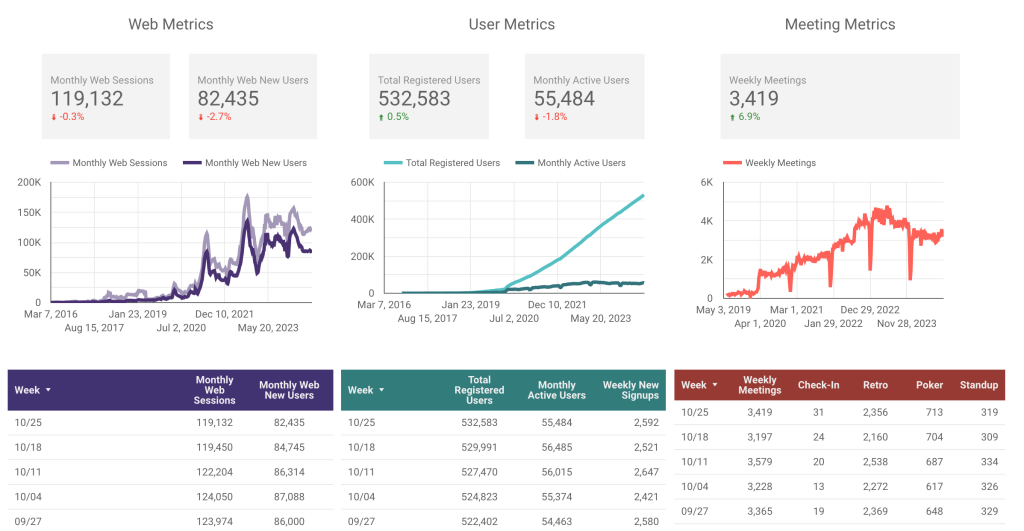#418 “Safest to Try” is Not Alive
Friday Ship #418 | October 25th, 2024

This week, we reflected on past Parabol strategy and the amount of risk we had been comfortable taking on.
In 2020, Parabol raised a significant round of funding from M12 (Microsoft’s venture firm) and began hiring as quickly as possible. We were growing from a core team of about five members. For the five years leading up to that point, we had worked diligently to define our culture. We knew who we were hiring: people who could operate with a high degree of autonomy, who shared and expected transparency from leadership and colleagues, and who assumed the best intent of others while empathizing with our users and each other. We developed rubrics and methods to identify these qualities in candidates. However, nearly ten years into Parabol, I’ve come to believe that these criteria alone weren’t quite enough.
Getting Nowhere Slowly
My early career in Corporate America is filled with memories of seeing some of my best ideas killed by sober-looking executives with fresh haircuts, pressed shirts, pleated khakis, and tasseled loafers—presenting a model of masculinity that functioned as a monument to their aversion to risk. I spent years of my life in meetings, locked in a perpetual state of deadlock. Months of careful consensus-building could be undone by a single person who “wasn’t quite sure” or suggested we “take a step back.”
Getting Somewhere Fast
Later in my career, I joined a management consultancy called Undercurrent. One of our partners introduced us to the concept of facilitated, consent-based decision-making. Instead of “getting in a room” with no assurance that action would be taken, groups that chose this process agreed to make decisions even without full consensus. We consented to the outcome of a process as long as it was “safe to try.” This seemingly simple phrase is central to the consent process: as long as the decision won’t lead to irreversible harm, it’s safe enough to pursue and learn from. This approach acknowledges that inaction is often riskier than imperfect action. (Jeff Bezos reinforced Amazon’s culture by distinguishing between “two-way decisions”—where failure is survivable—and “one-way decisions,” which require slower, more careful deliberation.)
When we adopted consent-based decision-making at Undercurrent, it led to the most sustained period of growth in the firm’s history. When I started Parabol, I brought this process with me.
Building With Those Who Consent
Most of the experienced hires at Parabol understood why we implemented consent-based decision-making. They, too, had endured endless meetings and deadlock. Our hiring process successfully selected individuals who valued and participated in this way of working. Our company and product improved, and I believe Parabol still exists largely because of how we make decisions.
At some point, we hired so many people into our product team that the organization became unwieldy to manage as a single unit. We divided into smaller “squads” tasked with improving a segment of the user or customer journey. After a time, I began to feel that what we shipped didn’t reflect our full potential. We were avoiding essential problems and focusing on incremental improvements instead. During critiques, I would often ask, “If we rolled back the changes we made, would anyone feel like their life just got significantly more difficult?” Our data platforms confirmed this critique: the majority of A/B tests showed no statistically significant impact toward its objective.
Don’t Ship What Is “Safest to Try”
How did our team arrive at decisions with so little impact? Every decision at Parabol is journaled, and when we reviewed our inputs and outputs, it became clear that we were rightfully focused on reducing big ideas to their smallest viable components for quick release and feedback. The issue wasn’t in the reduction of scope—it was that the “big ideas” we were prioritizing weren’t actually that big or consequential. After consenting and downsizing them, what we shipped was often, as Parabol’s Head of Design Terry Acker put it, “safest to try.”
Dreaming Bigger
When I spoke with team members at the time, many didn’t realize another option was available. It wasn’t that they felt unsafe taking on more risk or bolder initiatives—it’s that they couldn’t envision what a bigger risk might look like. This is the core of the issue. During our hiring evaluations, we hadn’t selected for people who could advocate for and champion big ideas. This remains a key concern for the company. Since our product’s launch into the Agile market in 2017, we quickly established ourselves as the leading platform for facilitating Agile ceremonies. However, we’ve always aspired to be more. To achieve our potential we must cultivate our ability to dream up big ideas and consent to ship the smallest consequential piece of them quickly. As we place bets on where to invest our Product team’s time, we’ll be allocating more time to exploration without the pressure to ship into production so that we can find the product increments that truly matter. This doesn’t mean we won’t ship quickly and continuously, we will: but shipping to our production SaaS will no longer be the only destination. Prototypes in code will be given equal weight as valued creative output.
I don’t want to downplay our company’s accomplishments or the legacy of the people who helped build them. Instead, I want to take responsibility as Parabol’s CEO for the role I played in shaping its culture and share these lessons for the benefit of current and future leaders.
Metrics

As 2024 has entered its final quarter we’re seeing a clear trendline emerge of an overall increase in the number of meetings run each week. That’s great! We’ll need to keep an eye on the number of new web sessions, as traffic growth may be leveling off.
This week we…
…attended AFCEA TechNet Info-Pacific in Honolulu Hawaii. We had our second ever trade show booth at the largest Indo-Pacific U.S. defense-themed technology conference. We’ll have more to share (with pictures of our booth) in a future Friday Ship about how the show went!
…decommissioned RethinkDB from our production SaaS. We’ve completely migrated from RethinkDB to Postgres, simplifying operations. We’ll also dedicate a future Friday Ship to this work.
…wrapped up strategic planning for 2024 T3.
Next week we’ll
…kick off Shape Up Cycle 5. We’ll begin a new six-week product development cycle, betting on work in-line with our refreshed strategy.
